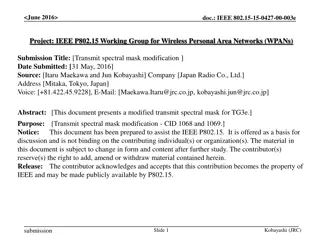Efficient Network Design with Variable Length Subnet Mask
Variable-Length Subnet Masking (VLSM) offers a more efficient way of subnetting a network compared to classical subnetting. By using different subnet masks for different networks, VLSM allows for a more optimal utilization of IP addresses. This involves determining the number of host bits needed for each network, selecting appropriate subnets, and assigning network addresses. VLSM minimizes wasted IP space, making network design more flexible and scalable.
Download Presentation

Please find below an Image/Link to download the presentation.
The content on the website is provided AS IS for your information and personal use only. It may not be sold, licensed, or shared on other websites without obtaining consent from the author.If you encounter any issues during the download, it is possible that the publisher has removed the file from their server.
You are allowed to download the files provided on this website for personal or commercial use, subject to the condition that they are used lawfully. All files are the property of their respective owners.
The content on the website is provided AS IS for your information and personal use only. It may not be sold, licensed, or shared on other websites without obtaining consent from the author.
E N D
Presentation Transcript
Designing the network, IP addressing and Subnets, designing using Variable Length Subnet Mask Dr. Mohamed Abd-Eldayem
Variable-Length Subnet Masking (VLSM) is the more realistic way of subnetting a network to make for the most efficient use of all of the bits. Classful (classical) subnetting are inefficient because all subnets have the same number of hosts because they all use the same subnet mask. For example, if you borrow 4 bits on a Class C network, you end up with 14 valid subnets of 14 valid hosts. 2
A serial link to another router only needs 2 hosts, but with classical subnetting, you end up wasting 12 of those hosts. VLSM is the process of subnetting a subnet and using different subnet masks for different networks in your IP plan.
With classical subnetting, you always have to eliminate the subnets that contain either all zeros or all ones in the subnet portion. Number of valid subnets =2N 2 Cisco devices can use those subnets, as long as the command (ip subnet-zero) is in the configuration. (Router(config)#ip subnet-zero). Hence, number of valid subnets =2N 4
Determine how many H bits will be needed to satisfy the largest network. Pick a subnet for the largest network to use. Pick the next network to work with. Pick the third network to work with. Determine network numbers for serial links. 1) 2) largest 3) largest 4) 5) 5
2H 2 50, Therefore H = 6 for Network A You need 6 H bits, 2 N bits (8 6 ) to create subnets Now have: NNHHHHHH (The 8 bits in the fourth octet) All subnetting will now have to start at this reference point. We have 2N or 22 or 4 subnets: If you add all zeros to the H bits, you are left with the network numbers for the four subnets: 00000000 = .0 01000000 = .64 10000000 = .128 11000000 = .192 NN = 00HHHHHH 01HHHHHH 10HHHHHH 11HHHHHH Network Address for all subnets Network A All of these subnets will have the same subnet mask: 11111111.11111111.11111111.11000000 Or 255.255.255.192 or /26 , The /x notation represents how to show different subnet masks when using VLSM. /26 means that the first 26 bits of the address are network; the remaining 6 bits are H bits. 6
Pick one of the remaining /26 networks to work with Network B. Select 128/26 network: 10000000 But you need only 5 H bits, not 6. Therefore, you are left with 10N00000 Where 10 represents the original pattern of subnetting. N represents the extra bit. 00000 represents the 5 H bits you need for Network B. Because you have extra bit, you can create two smaller subnets from the original subnet: 10000000 =.128 and 10100000 =.160 7
You have now subnetted a subnet! This is the basis of VLSM. The mask now equals: 11111111.11111111.11111111.11100000 or 255.255.255.224 or /27 Pick one of these new sub-subnets for Network B: 10000000 /27 = Network B Use the remaining sub-subnet for future growth, You want to make sure the addresses are not overlapping with each other. So go back to the original table.
2H 2 12, H = 4, Networks C and Network D = 12 hosts each. You can chose .192/26 network, or .160/27 network. (select 160/27): 10100000 But you only need 4 H bits, not 5. Therefore, you are left with 101N0000 Because you have this extra bit, you can create two smaller subnets from the original subnet: 10100000 = .160 and 10110000 = .176, Masks will be 11111111.11111111.11111111.11110000 or 255.255.255.240 or /28 Pick one of these new sub-subnets for Network C and one for Network D. 10
All serial links between routers have the same property in that they only need two addresses in a network one for each router interface. Determine the number of H bits needed for these networks: 2H 2 2, H = 2 You need 2 H bits to satisfy the requirements of Networks E, F, G, and H. You have two of the original subnets left to work with. Select the .0/26 network: 00000000
But you need only 2 H bits, not 6. Therefore, you are left with 00NNNN00 where 00 represents the original pattern of subnetting. NNNN represents the extra bits you have. 00 represents the 2 H bits you need for the serial links. Because you have 4 N bits, you can create 16 sub-subnets from the original subnet: 00000000 = .0/30 00000100 = .4/30 00001000 = .8/30 00001100 = .12/30 00010000 = .16/30 ........................... ........................... 00111000 = .56/30 00111100 = .60/30 You need only four of them. You can hold the rest for future expansion Going back to the original table 13
No subnet number is used twice. You have now created an IP plan for the network and have made the plan as efficient as possible, wasting no addresses in the serial links and leaving room for future growth. This is the power of VLSM!























